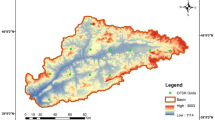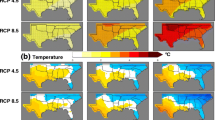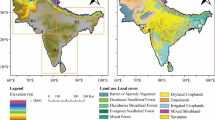Abstract
Drought is considered to be one of the most devastating natural hazards, causing widespread environmental and social damage in many parts of the world. Using standardized precipitation index, this work has assessed changes in the severity–area–frequency (SAF) relationship curve of seasonal droughts in Bangladesh. Changes were estimated for mild, moderate, severe and extreme droughts for the four climatic seasons; winter, pre-monsoon, monsoon, post-monsoon, and for the two major growing seasons; rabi (November to April) and kharif (May to October). Nineteen general circulation models (GCMs) of Couple Model Intercomparison Project 5 were used. The model output statistics approach was used to downscale GCM simulated rainfall for eighteen climate stations in Bangladesh. Changes in the SAF curve were computed for three periods (2010–2039, 2040–2069 and 2070–2099). The uncertainty band of the SAF relationship curve was then computed using the Bayesian bootstrap method at the 95% confidence level. The results reveal that moderate and severe drought categories have the highest return period and are likely to affect the region more than other types of droughts. The kharif season drought was found to be most pronounced and affected significant portions of the country during all return periods and severity categories. Projections also show that monsoon and kharif droughts would increase across Bangladesh in regards of severity and return period. Higher return period droughts were also projected to increase in aerial extent in the middle of this century (2040–2069).










Similar content being viewed by others
References
Adarsh S, Karthik S, Shyma M, Prem GD, Parveen AS, Sruthi N (2018) Developing short term drought severity–duration–frequency curves for kerala meteorological subdivision, India using bivariate copulas. KSCE J Civ Eng 22:962–973
Ahammed SJ, Homsi R, Khan N et al (2019) Assessment of changing pattern of crop water stress in Bangladesh. Environ Dev Sustain. https://doi.org/10.1007/s10668-019-00400-w
Ahmed K, Shahid S, Nawaz N (2018) Impacts of climate variability and change on seasonal drought characteristics of Pakistan. Atmos Res 214:364–374
Ahmed K, Shahid S, Chung E-S, Wang X-J, Harun SB (2019) Climate change uncertainties in seasonal drought severity-area-frequency curves: case of arid region of Pakistan. J Hydrol 570:473–485. https://doi.org/10.1016/j.jhydrol.2019.01.019
Alamgir M, Shahid S, Hazarika MK, Nashrrullah S, Harun SB, Shamsudin S (2015) Analysis of meteorological drought pattern during different climatic and cropping seasons in Bangladesh. J Am Water Resour Assoc 51:794–806
Amirataee B, Montaseri M, Rezaie H (2018) Regional analysis and derivation of copula-based drought severity–area–frequency curve in Lake Urmia basin, Iran. J Environ Manag 206:134–144. https://doi.org/10.1016/j.jenvman.2017.10.027
Angeles-Malaspina M, González-Cruz JE, Ramírez-Beltran N (2018) Projections of heat waves events in the intra-Americas region using multimodel ensemble. Adv Meteorol. https://doi.org/10.1155/2018/7827984
Beecham S, Rashid M, Chowdhury RK (2014) Statistical downscaling of multi-site daily rainfall in a South Australian catchment using a generalized linear model. Int J Climatol 34:3654–3670
Bisht DS, Sridhar V, Mishra A, Chatterjee C, Raghuwanshi NS (2019) Drought characterization over India under projected climate scenario. Int J Climatol 39:1889–1911
Bonaccorso B, Peres DJ, Castano A, Cancelliere A (2015) SPI-based probabilistic analysis of drought areal extent in Sicily. Water Resour Manag 29:459–470
Burke EJ, Brown SJ (2010) Regional drought over the UK and changes in the future. J Hydrol 394:471–485
Chu JT, Xia J, Xu CY, Singh VP (2010) Statistical downscaling of daily mean temperature, pan evaporation and precipitation for climate change scenarios in Haihe River, China. Theor Appl Climatol 99:149–161. https://doi.org/10.1007/s00704-009-0129-6
Dash B, Rafiuddin M, Khanam F, Islam MN (2012) Characteristics of meteorological drought in Bangladesh. Nat Hazards 64:1461–1474
Dewan A, Hu K, Kamruzzaman M, Uddin MR (2019) Chapter eight - Evaluating the spatiotemporal pattern of concentration, aggressiveness and seasonality of precipitation over Bangladesh with time–series Tropical Rainfall Measuring Mission data. In: Maggioni V, Massari C (eds) Extreme hydroclimatic events and multivariate hazards in a changing environment. Elsevier, pp 191–219. https://doi.org/10.1016/B978-0-12-814899-0.00008-0
Eden JM, Widmann M (2014) Downscaling of GCM-simulated precipitation using model output statistics. J Clim 27:312–324
Efron B (1992) Bootstrap methods: another look at the jackknife. In: Kotz S, Johnson NL (eds) Breakthroughs in statistics. Springer Series in Statistics (Perspectives in Statistics). Springer, New York, NY, pp 569–593
Fowler HJ, Blenkinsop S, Tebaldi C (2007) Linking climate change modelling to impacts studies: recent advances in downscaling techniques for hydrological modelling. Int J Climatol J R Meteorol Soc 27:1547–1578
Gaitán E, Monjo R, Pórtoles J, Pino-Otín MR (2019) Projection of temperatures and heat and cold waves for Aragón (Spain) using a two-step statistical downscaling of CMIP5 model outputs. Sci Total Environ 650:2778–2795
Goswami BN, Madhusoodanan MS, Neema CP, Sengupta D (2006) A physical mechanism for North Atlantic SST influence on the Indian summer monsoon. Geophys Res Lett 33:L02706. https://doi.org/10.1029/2005GL024803
Gudmundsson L, Bremnes J, Haugen J, Engen-Skaugen T (2012) Downscaling RCM precipitation to the station scale using statistical transformations—a comparison of methods. Hydrol Earth Syst Sci 16:3383–3390
Hao Z, Singh VP, Xia Y (2018) Seasonal drought prediction: advances, challenges, and future prospects. Rev Geophys 56:108–141
Henriques A, Santos M (1999) Regional drought distribution model. Phys Chem Earth Part B Hydrol Oceans Atmos 24:19–22
Herrera-Estrada JE, Sheffield J (2017) Uncertainties in future projections of summer droughts and heat waves over the contiguous United States. J Clim 30:6225–6246
Himayoun D, Roshni T (2019) Spatio-temporal variation of drought characteristics, water resource availability and the relation of drought with large scale climate indices: a case study of Jhelum basin, India. Quat Int 525:140–150
Khan N, Shahid S, Ahmed K, Ismail T, Nawaz N, Son M (2018) Performance assessment of general circulation model in simulating daily precipitation and temperature using multiple gridded datasets. Water 10:1793
Khan N et al (2019a) Spatial distribution of secular trends in rainfall indices of Peninsular Malaysia in the presence of long-term persistence. Meteorol Appl. https://doi.org/10.1002/met.1792
Khan N, Shahid S, bin Ismail T, Wang X-J (2019b) Spatial distribution of unidirectional trends in temperature and temperature extremes in Pakistan. Theor Appl Climatol 136:899–913
Khan N, Shahid S, Chung E-S, Kim S, Ali R (2019c) Influence of surface water bodies on the land surface temperature of Bangladesh. Sustainability 11:6754
Khan N, Shahid S, Juneng L, Ahmed K, Ismail T, Nawaz N (2019d) Prediction of heat waves in Pakistan using quantile regression forests. Atmos Res 221:1–11. https://doi.org/10.1016/j.atmosres.2019.01.024
Khan N, Shahid S, Ahmed K, Wang X, Ali R, Ismail T, Nawaz N (2020) Selection of GCMs for the projection of spatial distribution of heat waves in Pakistan. Atmos Res 233:104688. https://doi.org/10.1016/j.atmosres.2019.104688
Knutti R, Masson D, Gettelman A (2013) Climate model genealogy: generation CMIP5 and how we got there. Geophys Res Lett 40:1194–1199
Kundzewicz ZW et al (2008) The implications of projected climate change for freshwater resources and their management. Hydrol Sci J 53:3–10
Lim E-P, Hendon HH, Anderson DL, Charles A, Alves O (2011) Dynamical, statistical–dynamical, and multimodel ensemble forecasts of Australian spring season rainfall. Mon Weather Rev 139:958–975
Maraun D et al (2010) Precipitation downscaling under climate change: recent developments to bridge the gap between dynamical models and the end user. Rev Geophys 48:RG3003. https://doi.org/10.1029/2009RG000314
McKee TB, Doesken NJ, Kleist J (1993) The relationship of drought frequency and duration to time scales. In: Proceedings of the 8th conference on applied climatology, vol 22. American Meteorological Society, Boston, pp 179–183
Mishra V, Cherkauer KA (2010) Retrospective droughts in the crop growing season: implications to corn and soybean yield in the Midwestern United States. Agric For Meteorol 150:1030–1045
Mishra A, Desai V (2005) Spatial and temporal drought analysis in the Kansabati river basin, India. Int J River Basin Manag 3:31–41
Mishra AK, Singh VP (2009) Analysis of drought severity–area–frequency curves using a general circulation model and scenario uncertainty. J Geophys Res 114:D06120. https://doi.org/10.1029/2008JD010986
Mishra V, Shah R, Thrasher B (2014) Soil moisture droughts under the retrospective and projected climate in India. J Hydrometeorol 15:2267–2292
Mitra S, Srivastava P, Lamba J (2018) Probabilistic assessment of projected climatological drought characteristics over the Southeast USA. Clim Change 147:601–615
Mohsenipour M, Shahid S, Chung E-S, Wang X-J (2018) Changing pattern of droughts during cropping seasons of Bangladesh. Water Resour Manag 32:1555–1568
Mortuza MR, Moges E, Demissie Y et al (2019) Historical and future drought in Bangladesh using copula-based bivariate regional frequency analysis. Theor Appl Climatol 135:855–871. https://doi.org/10.1007/s00704-018-2407-7
Ng JL, Aziz SA, Huang YF, Mirzaei M, Wayayok A, Rowshon M (2019) Uncertainty analysis of rainfall depth duration frequency curves using the bootstrap resampling technique. J Earth Syst Sci 128:113
Noor M, Ismail T, Chung E-S, Shahid S, Sung J (2018) Uncertainty in rainfall intensity duration frequency curves of peninsular Malaysia under changing climate scenarios. Water 10:1750
Ouyang F, Zhu Y, Fu G, Lü H, Zhang A, Yu Z, Chen X (2015) Impacts of climate change under CMIP5 RCP scenarios on streamflow in the Huangnizhuang catchment. Stoch Environ Res Risk Assess 29:1781–1795
Panofsky HA, Brier GW (1958) Some application of statistics to meteorology. Mineral Industries Extension Services, College of Mineral Industries, Pennsylvania State University, University Park, PA
Payab AH, Türker U (2018) Analyzing temporal–spatial characteristics of drought events in the northern part of Cyprus. Environ Dev Sustain 20:1553–1574. https://doi.org/10.1007/s10668-017-9953-5
Pour SH, Shahid S, Chung E-S, Wang X-J (2018) Model output statistics downscaling using support vector machine for the projection of spatial and temporal changes in rainfall of Bangladesh. Atmos Res 213:149–162. https://doi.org/10.1016/j.atmosres.2018.06.006
Rahman MR, Lateh H (2016) Meteorological drought in Bangladesh: assessing, analysing and hazard mapping using SPI, GIS and monthly rainfall data. Environ Earth Sci 75:1026
Rajeevan M, Pai DS, Anil Kumar R, Lal B (2007) New statistical models for long-range forecasting of southwest monsoon rainfall over India. Clim Dyn 28:813–828. https://doi.org/10.1007/s00382-006-0197-6
Rashid H (1991) Geography of Bangladesh. The University Press Limited (UPL), Dhaka
Rubin DB (1981) The bayesian bootstrap. Ann Statist 9(1):130–134. www.jstor.org/stable/2240875. Accessed 30 Jan 2020
Sa’adi Z, Shahid S, Chung E-S, bin Ismail T (2017) Projection of spatial and temporal changes of rainfall in Sarawak of Borneo Island using statistical downscaling of CMIP5 models. Atmos Res 197:446–460
Sachindra D, Huang F, Barton A, Perera B (2013) Least square support vector and multi-linear regression for statistically downscaling general circulation model outputs to catchment streamflows. Int J Climatol 33:1087–1106
Sachindra DA, Ahmed K, Shahid S, Perera BJC (2018) Cautionary note on the use of genetic programming in statistical downscaling. Int J Climatol 38:3449–3465. https://doi.org/10.1002/joc.5508
Santos JF, Portela MM, Pulido-Calvo I (2011) Regional frequency analysis of droughts in Portugal. Water Resour Manag 25:3537
Shahid S (2010) Rainfall variability and the trends of wet and dry periods in Bangladesh. Int J Climatol 30:2299–2313
Shahid S (2011a) Impact of climate change on irrigation water demand of dry season Boro rice in northwest Bangladesh. Clim Change 105:433–453
Shahid S (2011b) Trends in extreme rainfall events of Bangladesh. Theor Appl Climatol 104:489–499
Shahid S, Behrawan H (2008) Drought risk assessment in the western part of Bangladesh. Nat Hazards 46:391–413
Sharma S, Mujumdar P (2017) Increasing frequency and spatial extent of concurrent meteorological droughts and heatwaves in India. Sci Rep 7:15582
Shiru MS, Shahid S, Chung E-S, Alias N (2019a) Changing characteristics of meteorological droughts in Nigeria during 1901–2010. Atmos Res 223:60–73. https://doi.org/10.1016/j.atmosres.2019.03.010
Shiru MS, Shahid S, Chung E-S, Alias N, Scherer L (2019b) A MCDM-based framework for selection of general circulation models and projection of spatio-temporal rainfall changes: a case study of Nigeria. Atmos Res 225:1–16
Shirvani A, Landman WA (2016) Seasonal precipitation forecast skill over Iran. Int J Climatol 36:1887–1900
Skahill BE, AghaKouchak A, Cheng L, Byrd A, Kanney J (2016) Bayesian inference of nonstationary precipitation intensity–duration–frequency curves for infrastructure design. Army Engineer Research and Development Center, Vicksburg
Sordo-Ward A, Bejarano M, Iglesias A, Asenjo V, Garrote L (2017) Analysis of current and future SPEI droughts in the La Plata basin based on results from the regional eta climate model. Water 9:857
Taylor KE (2001) Summarizing multiple aspects of model performance in a single diagram. J Geophys Res Atmos 106:7183–7192
Torres Rojas L, Díaz-Granados M (2018) The construction and comparison of regional drought severity–duration–frequency curves in two Colombian River Basins—study of the Sumapaz and Lebrija Basins. Water 10:1453
Turco M, Quintana-Seguí P, Llasat M, Herrera S, Gutiérrez JM (2011) Testing MOS precipitation downscaling for ENSEMBLES regional climate models over Spain. J Geophys Res 116:D18109. https://doi.org/10.1029/2011JD016166
Vicente-Serrano SM (2006) Differences in spatial patterns of drought on different time scales: an analysis of the Iberian Peninsula. Water Resour Manag 20:37–60
Webb JA, Stewardson MJ, Koster WM (2010) Detecting ecological responses to flow variation using Bayesian hierarchical models. Freshw Biol 55:108–126
Widmann M, Bretherton CS, Salathé EP Jr (2003) Statistical precipitation downscaling over the northwestern United States using numerically simulated precipitation as a predictor. J Clim 16:799–816
Woldemeskel F, Sharma A, Sivakumar B, Mehrotra R (2016) Quantification of precipitation and temperature uncertainties simulated by CMIP3 and CMIP5 models. J Geophys Res Atmos 121:3–17
Zahid M, Iqbal W (2015) Multi-model cropping seasons projections over Pakistan under representative concentration pathways. Model Earth Syst Environ 1:13
Author information
Authors and Affiliations
Corresponding author
Additional information
Publisher's Note
Springer Nature remains neutral with regard to jurisdictional claims in published maps and institutional affiliations.
Rights and permissions
About this article
Cite this article
Alamgir, M., Khan, N., Shahid, S. et al. Evaluating severity–area–frequency (SAF) of seasonal droughts in Bangladesh under climate change scenarios. Stoch Environ Res Risk Assess 34, 447–464 (2020). https://doi.org/10.1007/s00477-020-01768-2
Published:
Issue Date:
DOI: https://doi.org/10.1007/s00477-020-01768-2




